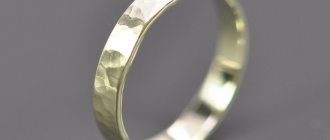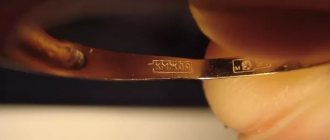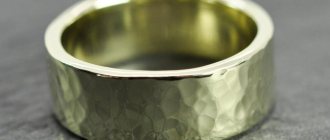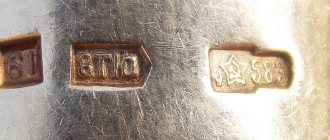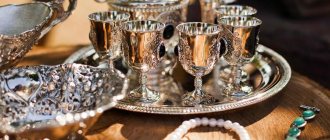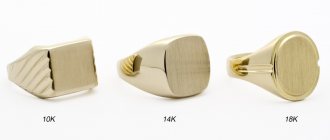The hallmark on gold is a guarantor of quality. This is what many people think when buying jewelry in jewelry stores. That’s right: the mark indicates that the product was tested by government agencies and corresponds to the specified standard, that is, the jewelry actually contains gold in the declared amount.
Stamp structure
For the first time, stamps began to be placed on jewelry in France; this happened back in the 13th century. In our country, filling precious metals began later. We have Peter the Great to thank for this - it was he who issued a decree that all silver and gold products must have a hallmark and hallmark. This happened in the 18th century. Over the years of history, the types of samples and the mark itself have changed appearance several times. Today, on jewelry you can see a girl in a kokoshnik, or rather, her profile.
What is a name tag on jewelry?
It is customary to call a unique trademark in the form of an imprint on each piece of jewelry made of precious metal. This special mark is subject to mandatory registration with government agencies that carry out assay control. In addition, the law provides for the mandatory presence of a unique mark for objects that have permission to manufacture products from precious metals.
By the way, our MosGold workshop produces custom jewelry, details here.
How not to make a mistake
When choosing a product made of precious metal, it is important not to purchase a fake. In addition to disappointment, such a purchase, if its cost is high, can lead to significant material losses. Since in Russia the sale of items made of precious metals that do not meet the established hallmarks is not permitted, the most reliable confirmation of the authenticity of jewelry is the presence of two different marks on it: the imprint of the state assay office and the name of the manufacturer.
First of all, you need to pay attention to the location of the print. It should be parallel to the decoration element on which it is placed. After this, it is worth looking at the quality of the content of the print. If the numbers are uneven, then this always means a fake. However, both requirements do not apply to the name plate, the imprint of which, different depending on the manufacturer, may correspond to the shape and size very conditionally. At the same time, the presence of both a sample and a name is mandatory. The presence of only a sample may mean that the metal is fake or the amount of gold does not correspond to the declared content in the alloy.
For manufacturers in many countries, quality control of products made of precious metals is not established by law and, for example, in a Turkish store you can not only buy jewelry without markings, but also put a stamp of any standard on it.
There are fakes in which the color of the alloy copies 585-carat gold, and even a qualified jeweler cannot always determine the authenticity of the metal without reagents. The only thing that gives away such a fake is the hallmark. It is impossible to forge a quality stamp without high-tech equipment, and the use of such a device deprives the forgery of any economic sense. A reliable guarantee against counterfeiting is a laser stamp.
In Russia, buying fake jewelry in a jewelry store is unlikely. By law, all products sold, including those imported from other countries, must have a state mark, but in order not to make a mistake or be deceived, you need to have a minimal understanding of what the marking of gold may be.
How to decipher the name code on jewelry
Initially, the name stamp was intended as a kind of code about the enterprise that produced the jewelry. Such a sign made it possible to determine without unnecessary procedures which factory produced each specific piece of jewelry. The appearance of a name on precious alloys made it possible to increase the quality control of manufactured embellishments several times at the state level.
To understand what the four-digit code next to the stamp means, you need to know what information is contained in each symbol. From left to right:
- Year of issue. Denoted by one Cyrillic letter from the beginning of the alphabet. Each letter is assigned its own year. So, for example, a piece of jewelry made in 2001 is A, 2002 is B, 2003 is C, and so on.
- Code of the State Assay Supervision Inspectorate. The second sign is determined by one of 16 letters, under which the territorial inspection is encrypted, which issued a permit to operate a specific plant or enterprise.
- Manufacturer code. Any person and enterprise involved in the production of jewelry is assigned its own unique code, which is part of the name. This two-digit cipher can consist of both numbers and letters, as well as their combinations.
In addition to the authenticity of the materials used to make jewelry, the assay service has specific requirements for the appearance of the name tag, which must have clear dimensions - 0.5 x 1.5 mm. Deviation from these standards may be a significant reason to refuse registration to the manufacturer.
How to enter
As the shapes of products became more complex and jewelry production technologies developed, electrical erosion and laser methods were added to the oldest, mechanical branding. The mechanical method, which remains the most widespread, consists of applying an impression by hand, hitting a stamping tool with a hammer, or performing a similar manipulation on a machine. The stamps are clear and durable, but there is some possibility of product deformation. Since the late sixties of the twentieth century, when branding hollow and fragile products, the electroerosive method has been used, which is the burning of an imprint with a spark. Such marks are also highly visible and durable, but their application requires careful preparation of the metal surface.
The most modern, universal and productive method of branding is laser, carried out using a laser machine. This method also requires good preparation of the surface of the product and eliminates its subsequent polishing. The quality of the branding is high, it is possible to place an imprint on the surface of any relief, but there is a significant drawback - instability in places of contact with the skin, which reduces the service life of the brand to 5 years with daily use of the product.
Sample of Russian gold
In the hallmark on jewelry made of precious metals, the key element is the gold purity, which symbolizes the proportion of pure component in relation to impurities. For example, the 999th sample consists of 999 parts of the purest gold out of 1000. Thus, the additional elements in this sample are only 1%.
In Russia, a metric standard system has been adopted, which directly indicates the gold content to tenths. That is, 585 standard is 58.5% gold, the rest is other metals, such as copper, zinc, silver, palladium, etc. 750 standard is 75% gold in the alloy . There is also a carat system, which involves dividing the total mass of the alloy into 24 parts. For example, a 14-karat gold product contains 14 parts of precious metal and 10 parts of impurities.
Gold hallmark is one of the elements of the hallmark, which is located on the inside of the ring, pendant holder, clasp of a chain or bracelet.
Current price per gram of 875 silver
Below is the rate chart: Silver standard 875 cost per gram in rubles.
As of May 30, 2022 the price per gram of silver 875 is 36 rubles. 53 kopecks
The cost of a silver item that has antique value will depend on the assessment of specialists. If it is an item with history or a piece of art, the cost of the item can be very high. It is not worth investing in 875 silver as a monetary weapon, although the price is quite stable, it will only be possible to sell it as scrap. To preserve capital, it is better to use metal ingots of a high standard, which are offered by banks.
Russian 585th standard gold
The 585th gold standard is one of the most common. In Soviet times it was 583, essentially the same thing. The gold content in the alloy has remained almost unchanged. This alloy made it possible to obtain an optimal combination of strength characteristics, relatively low cost and excellent color shade. Silver, copper, nickel and zinc are used as impurities.
Composition and properties of silver alloy with 875 purity
The number 875 means that per 1000 g of alloy there are 875 g of pure silver and 125 g of various impurities.
Soviet 875 silver has established itself as an example of quality, so products produced during the USSR, when standards were strictly adhered to, are valued much more than products with modern markings.
Nowadays, most often, copper is used as an alloy, which gives the product strength, but also a yellowish nuance. Aluminum, nickel, and cadmium can also be used as impurities. Each of the additives directly affects the paint and physical properties of the resulting alloy. Some production options may have used platinum and palladium. Interestingly, nickel and platinum give the alloy a color that cannot be distinguished from the color of white gold, which can be taken advantage of by unscrupulous sellers by offering to acquire an 875 gold item.
Source Jewelry (Authors: V.I. Marchenkov) p. 44.
How can you understand, by looking at the numbers 875 on the product, whether it is gold or silver?
Everything is quite simple: gold is not marked with the 875 hallmark, just like platinum. Only silver can have such markings.
The presence of copper in the composition, although it makes the alloy hard, causes rapid darkening of the metal. Therefore, almost always, products made from 875 silver are coated with gold, rhodium or enamel, which preserves and enhances their shine. Also, when copper is added, plasticity is lost, so it becomes difficult to give small elegant details to products.
Photo of 585 gold
To find out what standard the product is, just look at the stamp, in the frame of which there are numbers indicating the content of pure gold. Depending on the year of manufacture, the mark may have a different appearance:
- antique gold, produced before 1927, was designated according to the spool system and had only two numbers on the stamp - 56, which were located to the left of the girl in the kokoshnik with her head turned to the left,
- gold of the Soviet period was indicated by three numbers 583, located on the hallmark to the right of the imprint of a five-pointed star with a hammer and sickle in the center,
- a sample of modern Russian products made of “yellow” precious metal is applied to the right of the girl with a kokoshnik, whose head is turned to the right.
How to independently evaluate a product made of 875 silver?
It is possible to evaluate 875 silver by its hallmark; if the image is modern, then the cost of the product will vary from 20 to 40 rubles. per gram (at the Cetrobank rate).
If there is a mark on the product with the image of a five-pointed star or the head of a worker with a hammer, then it is difficult to determine the price of such a product on your own. Consider the brand; the boundaries should be clear. Perhaps this is a rarity that will be purchased tens or even hundreds of times more expensive than the cost of an ordinary alloy.
Advantages and disadvantages of 750 gold
The 750th gold standard is not as popular among buyers as the 585th, but it is also in demand. It contains a higher proportion of pure gold, which significantly increases the cost of the alloy, and at the same time the final product. Such jewelry is considered more elite, although it has a number of significant disadvantages, including:
- low strength due to the softness of the alloy;
- low resistance to mechanical damage;
- higher price.
Control of precious metals by assay inspection
The Russian State Assay Chamber is a regulatory body that has every right to refuse licensing to a private person or enterprise that produces jewelry that does not meet accepted standards.
The presence of a mark on jewelry is a kind of guarantee that the composition of the precious metal fully corresponds to the stamp numbers applied. The slightest deviation from the norms becomes a reason for revoking the license to produce jewelry, so manufacturers are interested in quality products .
Verification by analysis
In the practice of assay inspection, there are cases when jewelry does not meet the declared characteristics. In this case, the content of precious metals in the jewelry alloy is checked in the laboratory using destructive chemical analysis. The product is cut, a small part is taken from it - a sample of the alloy weighing 0.1-0.2 grams, in which the sample is determined through chemical transformations - the amount of pure precious metals in the alloy: silver or gold.
In addition to chemical analysis, the Assay Office staff checks products using an X-ray fluorescence analyzer. Photo: Alexey Kunilov
A sample of silver alloy is dissolved in acid and in the resulting solution, the silver content in the original jewelry alloy of the product is determined by the change in potential during a chemical reaction on a special device - an automatic titrator. Gold is tested differently using the fire assay method at a temperature of about 1000 degrees Celsius. A sample of the gold alloy is wrapped in a lead bag, which is sent into a heated furnace.
— The chemical laboratory of our inspection has been accredited since 2007 according to the international standard for the determination of gold and silver in jewelry alloys. The results of our analysis are recognized not only in Russia, but also abroad,” emphasized Svetlana Agafonova. – We are improving our qualifications and participating in various tests. In particular, they send us encrypted alloys from the Czech Republic, which we analyze. And for 20 years we have never had unsatisfactory results.
In addition to chemical analysis, the Assay Office staff checks products using a Prism X-ray fluorescence analyzer. Jewelry alloys may contain all sorts of components and impurities, and to confirm the sample of the precious metal, specialists use the Prism device for an initial check.
“In the chamber of the device, a beam of X-rays passes through the product, electrons are knocked out, the device displays a spectrogram on the screen with the element-by-element composition of the metals in the alloy,” explained Svetlana Zholudeva. – All data is recorded, and on their basis we make a conclusion about the conformity of the product with the declared sample. It cannot be lower than stated - we do not have minus tolerance in jewelry alloys.


